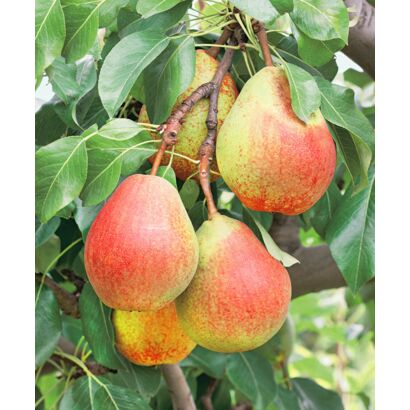Pear saplings grade Karataevskaya
Variety: self-pollinating
Fruits: 107-110 gr., red
Ripening: early autumn
Yield: 15-20 kg/tree
Zoning: Eastern Siberia
Selection: Altai Territory
| Selection | Russia |
| planting material | Pear |
Pear Karataevskaya was bred by scientists of the Federal Altai Scientific Center for Agrobiotechnology (Barnaul) by crossing varieties "Dessert Mliyevskaya"; and "Granddaughter". The new variety was named after one of the breeders – Elvira Karataeva. In 2011, the pear was included in the State Register with permission to grow in the East Siberian region.
Variety advantages: self-pollination, high yield, dessert taste of fruits, immunity to a number of fungal diseases.
Characteristics of the variety
Treeof medium height, 2-4 m high, in need of shaping. The crown is sparse, cone-shaped, lateral processes and buds are poorly developed. Shoots are reddish-brown, long, thickened. The leaves are ovate with serrated edges.
Fruits widely pear-shaped, medium-sized. The average weight of one pear – 107-110 gr. In mature fruits, the skin is – dark red. With technical (removable) maturity – one half of the pear is greenish-yellow. Pulp – whitish, fine-grained, very juicy. Taste – sweet and sour, tasting score 4.9 points and 5.
The shelf life of a pear in a warm room is short. In the refrigerator, the harvested crop does not spoil for up to 2 months.
Productivitypears «Karataevskaya» from 15-20 kg / tree, up to 114.7 c / ha (subject to the rules of planting and care). Ripening terms – early autumn, September 12-18. Fruiting is regular, starting from 4-5 years of planting.
Immuneto most fungal diseases. Under unfavorable conditions and in proximity to infected plants, the variety may be affected by black rot and scab. The main pest of Karataevskaya – green aphid. To reduce the risks of infection, preventive measures will help – sanitary cleaning, burning of fallen leaves and fruits, spring treatment with biological preparations.
Growing conditions. Frost and drought resistance of pear Karatevskaya is average. In a harsh winter with little snow, the tree may freeze slightly. Insufficient watering adversely affects the quality and taste of the fruit. Big plus grade – self-pollination, fruit formation does not depend on the presence of other pear varieties in the neighborhood.
Preparations
| Phase | Operation | Biopreparations | Comment |
|---|---|---|---|
| Pre-plant tillage | Disease treatment | SBT-Trichodermin TH82 | Fight against overwintering forms of pathogens 30-100 g/20 l of water per 1 weave |
| Pest control | SBT-Pecilomycin RM116 | wireworms. Soil pest control: larvae and adults of the May beetle, wireworm, mole cricket, etc. 100-150 g / 1 weave is applied by spreading |
|
| top dressing | SBT-Ekosoil | Stimulation of biological activity 50 g per 20 l of water / 1 weave |
|
| Organic fertilizer "TOR" | Main application in April Proportion 1:20 |
||
| root formation | Disease treatment | SBT-Fitolek BS26 | Soaking the roots of seedlings Prevention of the development of a wide range of fungal diseases 60 g/10 l for 50 pcs. seedlings |
| SBT-Trichodermin TH82 | Prevention of the development of a wide range of fungal diseases. Soaking the roots of seedlings 60 g/10 l for 50 pcs |
||
| Bloom | Disease treatment | SBT-Fitolek BS26 | Processing in the budding phase Prevention of powdery mildew, alternariosis, anthracnose, fomopsis, gray mold, curliness, septoria, tuberculariasis 40 g / 10 l per 1 weave |
| SBT-Trichodermin TH82 | Prevention of late blight, powdery mildew, root rot, gray mold, leaf spot 40 g/10 l per 100 m2 |
||
| Pest control | SBT-Actaro E | Processing in the budding phase Control of pests weevils, bronzovka, mites, aphids, sawflies. 10 g/10 l per 1 weave |
|
| top dressing | SBT-Biocomplex Amino | Stimulation of plant growth. Improvement of photosynthetic activity 20–30 ml/10 l per 1 hectare |
|
| Fruiting | Disease treatment | SBT-Fitolek BS26 | Prevention of powdery mildew, alternariosis, scab, gray mold, monilial and bacterial burns, clasterosporiasis, cytosporiasis, infectious drying of branches, bacterial cancer. During the period of fruit formation (3-4 treatments) at intervals of 20-25 days 40 g / 10 l per 1 weave 10-15 days before harvesting 40 g / 10 l per 1 weave |
| SBT-Trichodermin TH82 | During the period of fruit formation (3-4 treatments) at intervals of 20-25 days 40 g/10 l per 1 weave |
||
| After harvest | Disease treatment | SBT-Trichodermin TH82 | Autumn processing Reducing the stock of overwintering forms of pathogens spraying 120 g per 10–15 liters per 1 weave |
